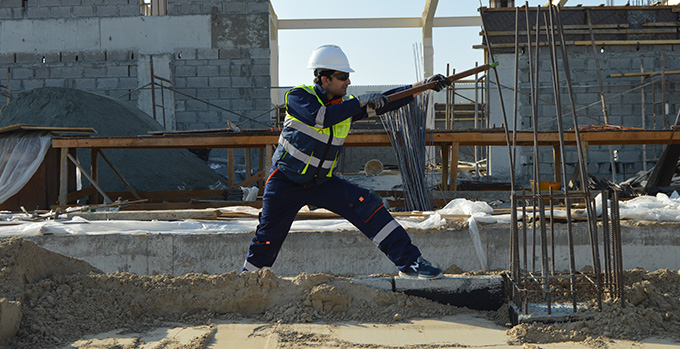The first-ever concrete produced dates back to 2650 BC
by Imhotep – a great Architect, Chemist and Doctor. He dissolved caustic soda
in water and the solution was mixed with locally available flaky limestone and
white clay (called Kaolin). This mixture gets hardened after 30 days of exposure
to sun heat and attained the compressive strength of 25 to 40 Mpa. Caustic soda
was produced when burnt lime was mixed with sodium carbonate from Natron
a place in Egypt, that is the reason even today Sodium is symbolised as Na.
This ancient concrete needed heat to attain strength while modern concrete
needs water to attain strength.
Construction of buildings around us happens using
varieties of materials depending on the purpose and location of the building. Traditional
construction materials like bricks, timber, stone, lime, clay tiles have been
in use for many centuries and dominated many civilizations right from the Vedic
period. The cement was invented during the early 1850s and has been in
construction and now it’s being the most widely consumed material after water.
Concrete is a mixture of sand, small stone pieces
(from granite rocks), water and cement. Cement and concrete have now become an integral
part of almost all constructions around the world. With the addition of steel, these
concretes become Reinforced Cement Concrete and which in turn has become the
modern construction composite. The consumption of these structural materials per
capita around the world is quite interesting. It is observed that in most of
the constructions nearly 2 to 3% of steel from gross concrete volume is
sufficient to build any structure.
Concrete
Strength and Constructions:
Concrete has great compressive strength, but it is equally weak in
tension having nearly 10% of compressive strength. That is why many designers
and IS Code 456-2000 ignore the tensile strength of concrete altogether and use
steel to resist tension. When we pull a rope from both ends the rope is in tension
and when a birthday cake is cut with a knife the cake is subjected to shear and
when we crush groundnuts it is compression. Cement Concrete along with properly
placed steel inside the concrete known as RCC has become a better composite for
any type of structures subjected to massive loads like earthquake, tsunamis, explosions
and blast loading.
Particular mix of proportions of concrete ingredients
will produce concrete of particular compressive strength. Normally concrete
used in most of the constructions varies from 20 Mpa to 100 Mpa. (1 N/mm2 =
1 Mpa). The concrete is named by its compressive strength as M10, M15, M20,
M25, M30, M35 i.e for 10, 15, 20, 25,
30, 35 Mpa after 28 days of water curing. The pyramids of Giza are subjected to
a stress of less than 10 Mpa at the bottommost coarse while their strength is
40 Mpa even after 4500 years.
Production
of Concrete:
In the private sector where large
public construct their own houses the
quality control on concrete production is very poor in India. Because most of
the contractors in concrete building construction are from a non-technical
background. Usually, the contractors will proportion the materials based on
their experience by not going for structural design or not considering the
grade of concrete given by the structural engineer. But it is not technically
correct and there are many examples where the concrete buildings have failed because
of the usage of under-strength concrete. It is estimated that 5% of air voids
inside the concrete eat away simply 30% of the strength. Workers add more water
to make it more fluid for their ease of lifting and placing. In any case, for 1
cement bag not more than 30 to 35 litres of water should be added.
The strength of concrete required for a project
depends on the probability of the severe loads acting during their useful life.
Nobody expected an aircraft will come and hit Twin Towers and explode inside.
Structural Engineers have to forecast what failure loads may act on a structure
during their entire life. The IS codes 875 and 1893 give detailed information
about general loadings and earthquake loads to be considered for the design of
any structures. After a complete analysis of the structure, one will arrive at the
actual strength of concrete required.
Most people know the ingredients of concrete i.e., cement,
sand, coarse aggregates (jelly) and water, but they are not sure about how much
quantity of each should be used to produce desired concrete strength. The
grades of concrete to be used in the construction may be different depending on
the column spacing, depth of the beam, depth of the slab, etc. Though the construction is taken care of by
the contractor, it is very important for every individual to know the
proportioning of materials so that the quality of the building construction is
maintained.
There are two ways the materials are proportioned, (a)
weigh batching and (b) volume batching. Where, the more accurate way of
proportioning, weigh batching is adopted in RMC (Ready Mixed Concrete) plant,
the volume batching is adopted when mixing the concrete at the site (commonly
adopted method of batching). In weighing, batching the materials are calculated
in terms of weight and it is very difficult to adopt at site as we need the
weighing balance, flat surface to place the weighing balance, etc. In volume,
batching the materials are proportioned by volume and it is an easier way for
proportioning of materials at site.
It is good to have knowledge about volume batching of
materials for different grades of concrete as it is the most adopted type
proportioning at the site. Here is the list of different grades of concrete of
grades up to M25 and the corresponding proportions of materials which are
normally permitted for site mixing by volume batching:
The
higher grades of concrete must have to be designed carefully and the proportioning
by volume batching shall be avoided.
Role
of water in concrete:
Concrete
gains strength by the process called hydration. This, in short, we call
hydration of cement in concrete. The presence of water in concrete from the
time of mixing of concrete till it gains its full strength is very important. Hence
water is applied to the concrete in two stages (1) adding water to the concrete
during mixing time (2) applying water to the surface of the concrete after the
structural member is cast and is called curing of concrete.
Concrete
should be mixed in such a consistency that the concrete can flow easily to the
very tight spaces where heavy reinforcement present in the structural element
known as workable concrete. The workable concrete can be obtained by increasing
the water content in the concrete but using excess water will reduce the
strength of concrete. Therefore, care must be taken while adding water to the
concrete during mixing. However, for a proper grade of concrete, the water-cement
ratio prescribed by the Indian Standard Code (IS: 10262) is recommended.
The
curing of concrete is also equally important in obtaining the full strength of the
concrete. But, what is curing and how many days we need to cure the concrete?
The
reaction between water and cement is exothermic and heat is thus produced. This
heat evaporates the water already present in the concrete. So, to continue to
have the reaction externally the water is supplied on surfaces of the concrete
and this is known as curing of concrete. The strength of the concrete in each
of the grades represents a compressive strength at its 28 days of age. The
concrete should be cured all these 28 days to make it attain its full
compressive strength. Experience shows us that the compressive strength
variation of concrete at various ages are as follows:

We can observe from the table that about
65% of strength of concrete is attained at 7 days of age and 90% strength of
the concrete is attained at 14 days of its age.
In the construction industry, the
contractors are having a very bad practice of removing the formwork and the
props on the very next day of casting of the concrete. Sometimes this practice
will be very unsafe. The stripping time of concrete should be at least a time
when the concrete gains strength to take up its own self weight with nominal
accidental load. Indian Code 456-2000 suggests the following stripping time for
formwork and the props based on the structural elements.

Life
of Cement Concrete Structures:
Modern
concrete seriously lacks its life span. Many of the concretologists firmly
believe that a structure well built under strict quality control and with a
very good geometric sense can’t last more than a healthy man’s lifetime. One may
live for 30 years and the other may live for 110 years depending on how their
health is maintained. We do not a have feedback of concrete structure having
more than 100 to 150 years. But, the Giza pyramid (of lime concrete) is more
than 4500 years old. Indeed, now it is the time to reinvent the wheel.
Written
by:
Prof. Taranath S.D.











0 Comments